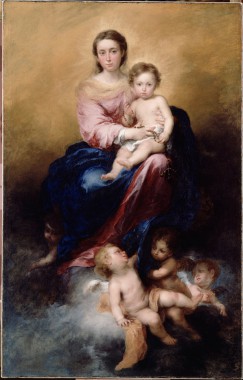In our previous post, we looked at what the Rosary is and what it does. In this post, we’ll look at the Hail Mary, the principal prayer of the Rosary, and what Mary teaches us through the Rosary.
 Catholics don’t worship the Blessed Virgin Mary, and anyone who says that we do is simply mistaken. You will not find a single line in any official Church document that uses the word “worship” in association with devotion to Mary. True, there may be some misinformed, well-intentioned Catholics who think they are supposed to worship her, but Catholic teaching is abundantly clear: adoration and worship is given to God alone: Father, Son, and Holy Spirit.
Catholics don’t worship the Blessed Virgin Mary, and anyone who says that we do is simply mistaken. You will not find a single line in any official Church document that uses the word “worship” in association with devotion to Mary. True, there may be some misinformed, well-intentioned Catholics who think they are supposed to worship her, but Catholic teaching is abundantly clear: adoration and worship is given to God alone: Father, Son, and Holy Spirit.
That being said, there’s no doubt that Mary ought to play a very significant role in the life of every Christian. There’s a difference between “honor” and “worship.” We honor Mary for the special grace and privilege that was given to her. In fact, by honoring Mary we imitate the Lord who honored her by becoming flesh in her womb. Yes, as Jesus literally entrusted himself to Mary, we too can entrust ourselves to her care and protection.
So what’s the deal with Catholics praying the “Hail Mary?”
No Christian can argue with the first part of the Hail Mary, for it is biblical. “Hail, full of grace! The Lord is with you,” were the words that the Archangel Gabriel spoke to Mary. “Blessed are you among women and blessed is the fruit of your womb,” were Elizabeth’s words to Mary upon hearing her greeting. By praying these words we are simply echoing the inspired words of Scripture.
But why the second part: “Holy Mary, Mother of God, pray for us sinners, now and at the hour of our death”? We believe Mary is holy because she is the vessel that carried Christ. We call her “Mother of God” very simply because it follows logically upon the fact that Jesus is God.
Many non-Catholic Christians struggle with the idea of asking Mary to pray for us. In a talk I once heard, the speaker shared his experience of talking to non-Catholic Christians about this very subject. He poses the question: “Do you ask your pastor to pray for you?” They answer: “Yes.” Then he simply asks: “If you had to choose between having your pastor or Jesus’ Mother pray for you, who would you choose?” The point is clear: if we ask those living on earth to pray for us, shouldn’t we also ask those who are with Christ in Heaven to pray for us, especially his mom!?
We can’t doubt that God chose Mary to play a very important part in salvation history. Her only desire is to lead us closer to Jesus, her Son. She knows him best! By honoring her and asking her to pray for us, she will help us to know and love him more.
And, how does she help us know and love him more? She teaches us through the Rosary. It’s a little school of faith. In it, she instructs us on the mysteries of our faith by having us gaze on God’s saving work. As we cast our eyes of faith on the truths we meditate on, we will necessarily have questions: What was it like for Mary to receive the Archangel Gabriel’s greeting? What did she feel in her heart? What of that moment when, renouncing fear, she chose faith, and a surge of confidence arose in her heart, “Behold, I am the handmaid of the Lord. May it be it done to me according to your word” (Luke 1:38). What thoughts did she ponder in her heart as she traveled to visit her cousin Elizabeth? What sentiments stirred in her soul when Elizabeth proclaimed, “Most blessed are you among women, and blessed is the fruit of your womb”? (Luke 1:42). What depth of tenderness was in her eyes—and her heart—as she gazed upon the newborn Christ in her arms with her beloved Joseph by her side? What did she feel when, in the Temple, she heard Simeon say to her: “And you yourself a sword will pierce”? (Luke 2:35). And what of the anxiety in her heart as she and Joseph searched for Jesus? And then the joy upon finding him?
These are just some of the questions we can meditate upon as we pray the Rosary. These are the mysteries—at least the Joyful ones—which we are led to ponder ever more deeply as the beads slip through our fingers. And as we contemplate these mysteries we grow in knowledge and love of the Lord.
The rosary is not chatter. It is not rote repetition of words with our lips disconnected from our hearts. When prayed from the heart, the rosary becomes, as some popes have stated, a “compendium of the Gospel.” It brings the Gospel to life, because when we pray the Rosary we see Christ’s life through Mary’s eyes. As Pope John Paul II was fond of saying, when we pray the Rosary we enter the “School of Mary.”
To see with Mary’s eyes. To feel with her heart. This is the interior reality of the Rosary. Rather than being a devotion that leads us away from Christ, it leads us closer to Him—much closer. For who was closer to Jesus than His mother? Who knew Him better? Who better to teach us about His life?
To pray the Rosary, to pray with Mary, is to learn and to love the Lord more. And isn’t this the deepest desire of every human heart?
Art: The Madonna of the Rosary, Bartolomé Estéban Murillo, between 1675-80, PD-US author’s life plus 100 years or less, Wikimedia Commons.




